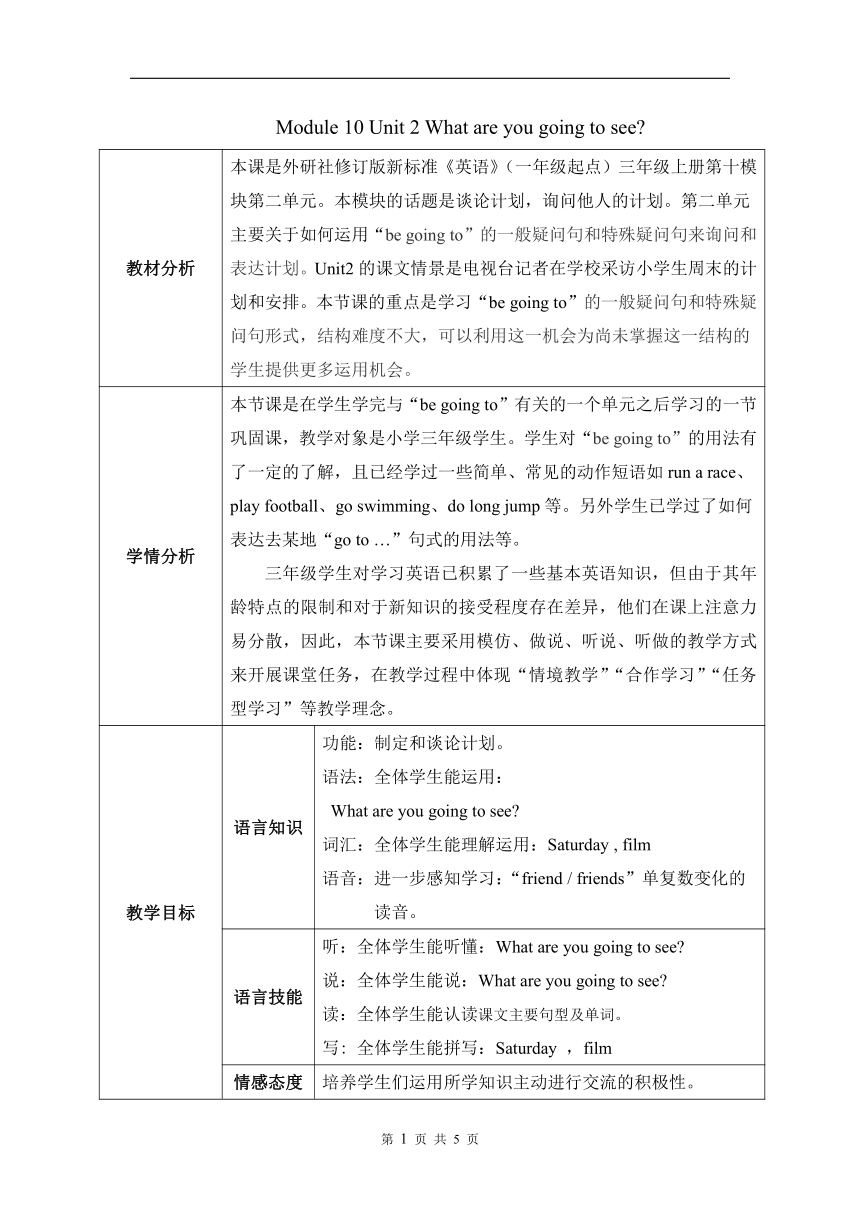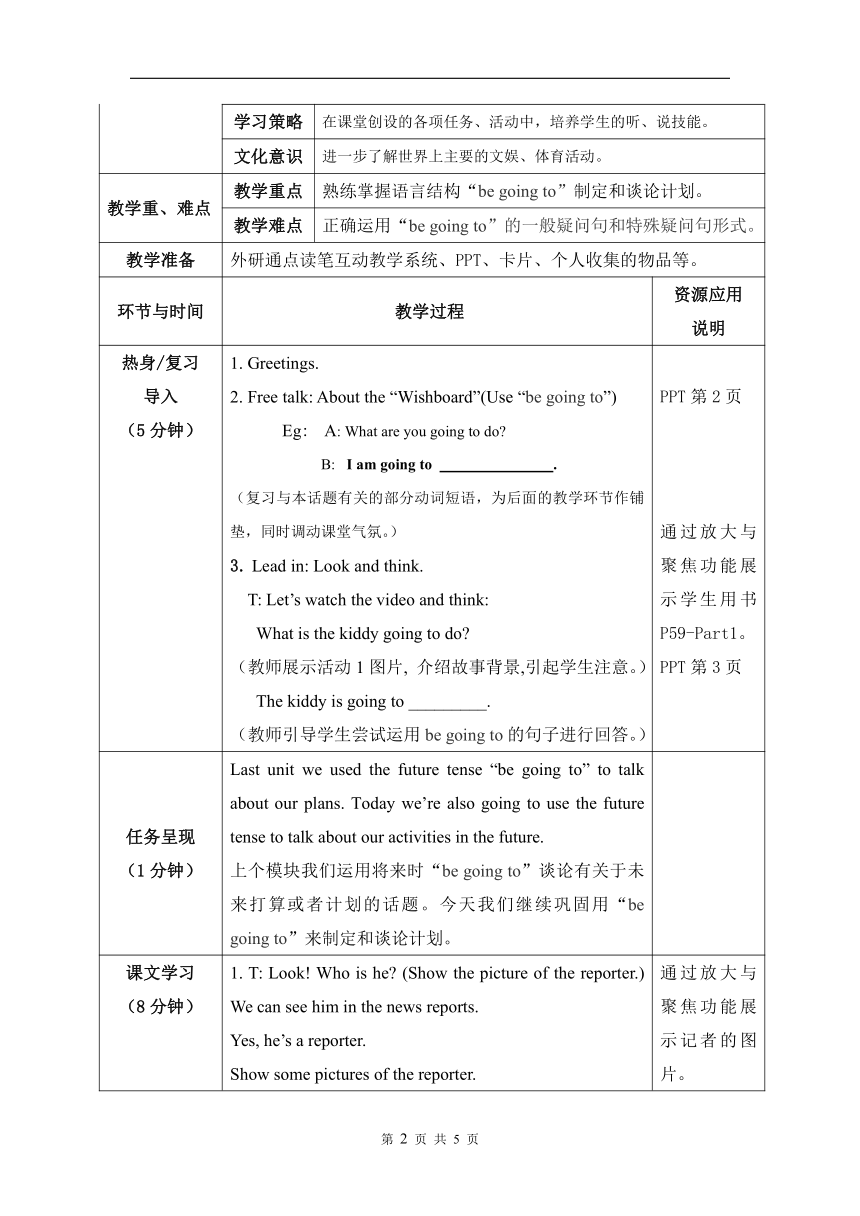Module 10 Unit 2 What are you going to see? 教案
文档属性
| 名称 | Module 10 Unit 2 What are you going to see? 教案 |  | |
| 格式 | doc | ||
| 文件大小 | 48.5KB | ||
| 资源类型 | 教案 | ||
| 版本资源 | 外研版(一年级起点) | ||
| 科目 | 英语 | ||
| 更新时间 | 2022-01-10 12:43:09 | ||
图片预览


文档简介
Module 10 Unit 2 What are you going to see
教材分析 本课是外研社修订版新标准《英语》(一年级起点)三年级上册第十模块第二单元。本模块的话题是谈论计划,询问他人的计划。第二单元主要关于如何运用“be going to”的一般疑问句和特殊疑问句来询问和表达计划。Unit2的课文情景是电视台记者在学校采访小学生周末的计划和安排。本节课的重点是学习“be going to”的一般疑问句和特殊疑问句形式,结构难度不大,可以利用这一机会为尚未掌握这一结构的学生提供更多运用机会。
学情分析 本节课是在学生学完与“be going to”有关的一个单元之后学习的一节巩固课,教学对象是小学三年级学生。学生对“be going to”的用法有了一定的了解,且已经学过一些简单、常见的动作短语如run a race、play football、go swimming、do long jump等。另外学生已学过了如何表达去某地“go to …”句式的用法等。 三年级学生对学习英语已积累了一些基本英语知识,但由于其年龄特点的限制和对于新知识的接受程度存在差异,他们在课上注意力易分散,因此,本节课主要采用模仿、做说、听说、听做的教学方式来开展课堂任务,在教学过程中体现“情境教学”“合作学习”“任务型学习”等教学理念。
教学目标 语言知识 功能:制定和谈论计划。语法:全体学生能运用: What are you going to see 词汇:全体学生能理解运用:Saturday , film 语音:进一步感知学习:“friend / friends”单复数变化的读音。
语言技能 听:全体学生能听懂:What are you going to see 说:全体学生能说:What are you going to see 读:全体学生能认读课文主要句型及单词。写: 全体学生能拼写:Saturday ,film
情感态度 培养学生们运用所学知识主动进行交流的积极性。
学习策略 在课堂创设的各项任务、活动中,培养学生的听、说技能。
文化意识 进一步了解世界上主要的文娱、体育活动。
教学重、难点 教学重点 熟练掌握语言结构“be going to”制定和谈论计划。
教学难点 正确运用“be going to”的一般疑问句和特殊疑问句形式。
教学准备 外研通点读笔互动教学系统、PPT、卡片、个人收集的物品等。
环节与时间 教学过程 资源应用说明
热身/复习导入(5分钟) 1. Greetings.2. Free talk: About the “Wishboard”(Use “be going to”) Eg: A: What are you going to do B: I am going to . (复习与本话题有关的部分动词短语,为后面的教学环节作铺垫,同时调动课堂气氛。)3. Lead in: Look and think.T: Let’s watch the video and think: What is the kiddy going to do (教师展示活动1图片, 介绍故事背景,引起学生注意。)The kiddy is going to _________.(教师引导学生尝试运用be going to的句子进行回答。) PPT第2页通过放大与聚焦功能展示学生用书 P59-Part1。PPT第3页
任务呈现(1分钟) Last unit we used the future tense “be going to” to talk about our plans. Today we’re also going to use the future tense to talk about our activities in the future.上个模块我们运用将来时“be going to”谈论有关于未来打算或者计划的话题。今天我们继续巩固用“be going to”来制定和谈论计划。
课文学习(8分钟) 1. T: Look! Who is he (Show the picture of the reporter.) We can see him in the news reports.Yes, he’s a reporter.Show some pictures of the reporter.(教师出示记者的图片并让学生了解记者的单词)2.T: Watch the video and think: What is the girl going to do on Saturday Ss:She’s going to see a film.(一听:PPT出示问题,学生理解课文大意。播放课文后尝试回答问题,同时教授新单词Saturday, film)3. Listen, point and find “going to”. Then read the sentences with “going to”(二听:用点读笔播放课文录音,让学生找出带有“going to”)4. Listen and imitate.(三听:听音模仿, 逐句播放, 教师及时纠正发音。)5. Listen in detail and answers.1. What is the girl going to see 2. What is the girl going to do on Saturday 3. What is the girl going to do in the class (四听:教师深入提问,小组合作解决问题。) 通过放大与聚焦功能展示记者的图片。PPT第4页点读笔播放学生用书P59-Part2PPT第5页通过聚焦功能进行单词教授。PPT第6/7页点读笔播放学生用书P59-Part2点读笔逐句点读。PPT第8页点读笔点击书上文字
训练巩固(15分钟) Act the dialogue.(二人小组表演课文对话)2. Look, ask and answer. (Activity3)(请学生看图,听音跟读,教师注意引导学生注意语音语调,进行大声朗读,并三人小组完成活动,每组15秒)3. Listen and say. Then sing. (Activity4)What are you going to do today (跟读歌词,齐读歌词,齐唱歌曲。)4. Think and follow.A: What are you going to see at the zoo lions. ducks.B: We’re going to see tigers. monkeys. pandas(利用聚焦功能展示每张动物图片,并利用黑屏计时完成最短时间内一口气说句子。) 佩戴头饰表演。点读笔播放学生用书活动3P60-Part3。黑屏计时。聚焦功能逐句歌词展示。点读笔播放活动4练习。通过聚焦功能展现活动5的动物图片。黑屏计时。
任务完成(6分钟) Task: Make a class survey.T: You are a reporter. Let’s make a class survey. (PPT shows the form of the class survey.)T: Please look at this. It’s a form of the class survey.Use “What are you going to do at the weekend ” to say something.(Teacher makes an example for students. Then students report.)(周末计划采访:任务设计了比较真实的采访情境,让学生感觉身临其境,鼓励学生广交朋友,并主动交流,句型也从中自然地得到拓展运用。每小组40秒) PPT第9页黑屏计时。随点名功能任意随机点名。
小结与布置作业(5分钟) 1. Summary.T: What have we learnt today Ss: Today, we have learnt “What are we going to do ” and “What are we going to see ”(让学生小组讨论自己总结本课学过的内容,并汇报。)2. Homework.Talk about your weekend plan with your friends. PPT第10页
板书设计 Module 10 Unit 2 What are you going to do I’m going to ……What are we going to see I’m going to see…..
film
Saturday
教材分析 本课是外研社修订版新标准《英语》(一年级起点)三年级上册第十模块第二单元。本模块的话题是谈论计划,询问他人的计划。第二单元主要关于如何运用“be going to”的一般疑问句和特殊疑问句来询问和表达计划。Unit2的课文情景是电视台记者在学校采访小学生周末的计划和安排。本节课的重点是学习“be going to”的一般疑问句和特殊疑问句形式,结构难度不大,可以利用这一机会为尚未掌握这一结构的学生提供更多运用机会。
学情分析 本节课是在学生学完与“be going to”有关的一个单元之后学习的一节巩固课,教学对象是小学三年级学生。学生对“be going to”的用法有了一定的了解,且已经学过一些简单、常见的动作短语如run a race、play football、go swimming、do long jump等。另外学生已学过了如何表达去某地“go to …”句式的用法等。 三年级学生对学习英语已积累了一些基本英语知识,但由于其年龄特点的限制和对于新知识的接受程度存在差异,他们在课上注意力易分散,因此,本节课主要采用模仿、做说、听说、听做的教学方式来开展课堂任务,在教学过程中体现“情境教学”“合作学习”“任务型学习”等教学理念。
教学目标 语言知识 功能:制定和谈论计划。语法:全体学生能运用: What are you going to see 词汇:全体学生能理解运用:Saturday , film 语音:进一步感知学习:“friend / friends”单复数变化的读音。
语言技能 听:全体学生能听懂:What are you going to see 说:全体学生能说:What are you going to see 读:全体学生能认读课文主要句型及单词。写: 全体学生能拼写:Saturday ,film
情感态度 培养学生们运用所学知识主动进行交流的积极性。
学习策略 在课堂创设的各项任务、活动中,培养学生的听、说技能。
文化意识 进一步了解世界上主要的文娱、体育活动。
教学重、难点 教学重点 熟练掌握语言结构“be going to”制定和谈论计划。
教学难点 正确运用“be going to”的一般疑问句和特殊疑问句形式。
教学准备 外研通点读笔互动教学系统、PPT、卡片、个人收集的物品等。
环节与时间 教学过程 资源应用说明
热身/复习导入(5分钟) 1. Greetings.2. Free talk: About the “Wishboard”(Use “be going to”) Eg: A: What are you going to do B: I am going to . (复习与本话题有关的部分动词短语,为后面的教学环节作铺垫,同时调动课堂气氛。)3. Lead in: Look and think.T: Let’s watch the video and think: What is the kiddy going to do (教师展示活动1图片, 介绍故事背景,引起学生注意。)The kiddy is going to _________.(教师引导学生尝试运用be going to的句子进行回答。) PPT第2页通过放大与聚焦功能展示学生用书 P59-Part1。PPT第3页
任务呈现(1分钟) Last unit we used the future tense “be going to” to talk about our plans. Today we’re also going to use the future tense to talk about our activities in the future.上个模块我们运用将来时“be going to”谈论有关于未来打算或者计划的话题。今天我们继续巩固用“be going to”来制定和谈论计划。
课文学习(8分钟) 1. T: Look! Who is he (Show the picture of the reporter.) We can see him in the news reports.Yes, he’s a reporter.Show some pictures of the reporter.(教师出示记者的图片并让学生了解记者的单词)2.T: Watch the video and think: What is the girl going to do on Saturday Ss:She’s going to see a film.(一听:PPT出示问题,学生理解课文大意。播放课文后尝试回答问题,同时教授新单词Saturday, film)3. Listen, point and find “going to”. Then read the sentences with “going to”(二听:用点读笔播放课文录音,让学生找出带有“going to”)4. Listen and imitate.(三听:听音模仿, 逐句播放, 教师及时纠正发音。)5. Listen in detail and answers.1. What is the girl going to see 2. What is the girl going to do on Saturday 3. What is the girl going to do in the class (四听:教师深入提问,小组合作解决问题。) 通过放大与聚焦功能展示记者的图片。PPT第4页点读笔播放学生用书P59-Part2PPT第5页通过聚焦功能进行单词教授。PPT第6/7页点读笔播放学生用书P59-Part2点读笔逐句点读。PPT第8页点读笔点击书上文字
训练巩固(15分钟) Act the dialogue.(二人小组表演课文对话)2. Look, ask and answer. (Activity3)(请学生看图,听音跟读,教师注意引导学生注意语音语调,进行大声朗读,并三人小组完成活动,每组15秒)3. Listen and say. Then sing. (Activity4)What are you going to do today (跟读歌词,齐读歌词,齐唱歌曲。)4. Think and follow.A: What are you going to see at the zoo lions. ducks.B: We’re going to see tigers. monkeys. pandas(利用聚焦功能展示每张动物图片,并利用黑屏计时完成最短时间内一口气说句子。) 佩戴头饰表演。点读笔播放学生用书活动3P60-Part3。黑屏计时。聚焦功能逐句歌词展示。点读笔播放活动4练习。通过聚焦功能展现活动5的动物图片。黑屏计时。
任务完成(6分钟) Task: Make a class survey.T: You are a reporter. Let’s make a class survey. (PPT shows the form of the class survey.)T: Please look at this. It’s a form of the class survey.Use “What are you going to do at the weekend ” to say something.(Teacher makes an example for students. Then students report.)(周末计划采访:任务设计了比较真实的采访情境,让学生感觉身临其境,鼓励学生广交朋友,并主动交流,句型也从中自然地得到拓展运用。每小组40秒) PPT第9页黑屏计时。随点名功能任意随机点名。
小结与布置作业(5分钟) 1. Summary.T: What have we learnt today Ss: Today, we have learnt “What are we going to do ” and “What are we going to see ”(让学生小组讨论自己总结本课学过的内容,并汇报。)2. Homework.Talk about your weekend plan with your friends. PPT第10页
板书设计 Module 10 Unit 2 What are you going to do I’m going to ……What are we going to see I’m going to see…..
film
Saturday
同课章节目录
- Module 1
- Unit 1 Do you use chopsticks in England?
- Unit 2 I'm eating hamburgers and chips.
- Module 2
- Unit 1 We're making a cake.
- Unit 2 I'm watching TV.
- Module 3
- Unit 1 These ducks are very naughty.
- Unit 2 The ducks are playing in the rain.
- Module 4
- Unit 1 I can jump far.
- Unit 2 What can you see?
- Module 5
- Unit 1 Can I have an ice cream?
- Unit 2 Can I come in?
- Module 6
- Unit 1 I've got new shorts and new shoes.
- Unit 2 He's got a new shirt.
- Module 7
- Unit 1 Have you got a headache?
- Unit 2 She's got a cold.
- Module 8
- Unit 1 This is Sam's book
- Unit 2 Is this your grandma's umbrella?
- Module 9
- Unit 1 I'm going to do long jump?
- Unit 2 I'm going to be a driver.
- Module 10
- Unit 1 Are you going to go to Hong Kong?
- Unit 2 What are you going to see?
- Review Module
- Unit 1
- Unit 2
